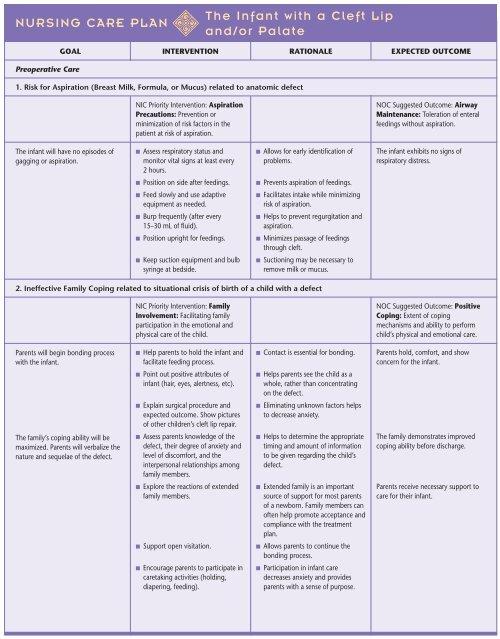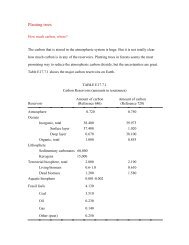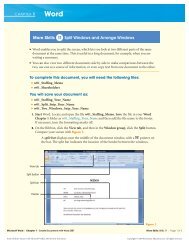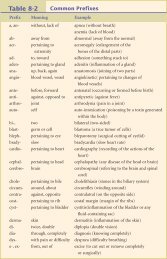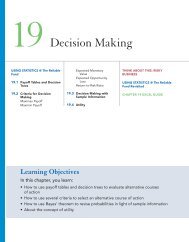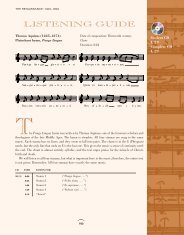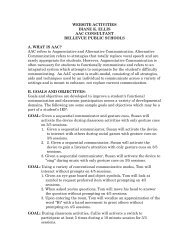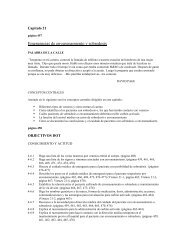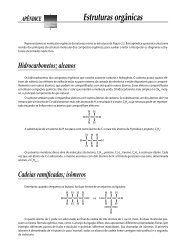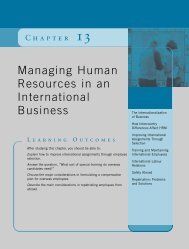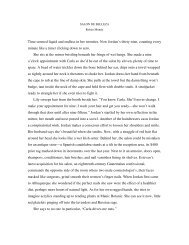590 NURSING CARE PLAN The Infant with a Cleft Lip and/or Palate
590 NURSING CARE PLAN The Infant with a Cleft Lip and/or Palate
590 NURSING CARE PLAN The Infant with a Cleft Lip and/or Palate
You also want an ePaper? Increase the reach of your titles
YUMPU automatically turns print PDFs into web optimized ePapers that Google loves.
<strong>NURSING</strong> <strong>CARE</strong> <strong>PLAN</strong><br />
Preoperative Care<br />
NIC Pri<strong>or</strong>ity Intervention: Aspiration<br />
Precautions: Prevention <strong>or</strong><br />
minimization of risk fact<strong>or</strong>s in the<br />
patient at risk of aspiration.<br />
■ Assess respirat<strong>or</strong>y status <strong>and</strong><br />
monit<strong>or</strong> vital signs at least every<br />
2 hours.<br />
■ Position on side after feedings.<br />
■ Feed slowly <strong>and</strong> use adaptive<br />
equipment as needed.<br />
■ Burp frequently (after every<br />
15–30 mL of fluid).<br />
■ Position upright f<strong>or</strong> feedings.<br />
■ Keep suction equipment <strong>and</strong> bulb<br />
syringe at bedside.<br />
NIC Pri<strong>or</strong>ity Intervention: Family<br />
Involvement: Facilitating family<br />
participation in the emotional <strong>and</strong><br />
physical care of the child.<br />
■ Help parents to hold the infant <strong>and</strong><br />
facilitate feeding process.<br />
■ Point out positive attributes of<br />
infant (hair, eyes, alertness, etc).<br />
■ Explain surgical procedure <strong>and</strong><br />
expected outcome. Show pictures<br />
of other children’s cleft lip repair.<br />
■ Assess parents knowledge of the<br />
defect, their degree of anxiety <strong>and</strong><br />
level of discomf<strong>or</strong>t, <strong>and</strong> the<br />
interpersonal relationships among<br />
family members.<br />
■ Expl<strong>or</strong>e the reactions of extended<br />
family members.<br />
■ Supp<strong>or</strong>t open visitation.<br />
■ Encourage parents to participate in<br />
caretaking activities (holding,<br />
diapering, feeding).<br />
<strong>The</strong> <strong>Infant</strong> <strong>with</strong> a <strong>Cleft</strong> <strong>Lip</strong><br />
<strong>and</strong>/<strong>or</strong> <strong>Palate</strong><br />
GOAL INTERVENTION RATIONALE EXPECTED OUTCOME<br />
1. Risk f<strong>or</strong> Aspiration (Breast Milk, F<strong>or</strong>mula, <strong>or</strong> Mucus) related to anatomic defect<br />
<strong>The</strong> infant will have no episodes of<br />
gagging <strong>or</strong> aspiration.<br />
■ Allows f<strong>or</strong> early identification of<br />
problems.<br />
■ Prevents aspiration of feedings.<br />
■ Facilitates intake while minimizing<br />
risk of aspiration.<br />
■ Helps to prevent regurgitation <strong>and</strong><br />
aspiration.<br />
■ Minimizes passage of feedings<br />
through cleft.<br />
■ Suctioning may be necessary to<br />
remove milk <strong>or</strong> mucus.<br />
2. Ineffective Family Coping related to situational crisis of birth of a child <strong>with</strong> a defect<br />
Parents will begin bonding process<br />
<strong>with</strong> the infant.<br />
<strong>The</strong> family’s coping ability will be<br />
maximized. Parents will verbalize the<br />
nature <strong>and</strong> sequelae of the defect.<br />
■ Contact is essential f<strong>or</strong> bonding.<br />
■ Helps parents see the child as a<br />
whole, rather than concentrating<br />
on the defect.<br />
■ Eliminating unknown fact<strong>or</strong>s helps<br />
to decrease anxiety.<br />
■ Helps to determine the appropriate<br />
timing <strong>and</strong> amount of inf<strong>or</strong>mation<br />
to be given regarding the child’s<br />
defect.<br />
■ Extended family is an imp<strong>or</strong>tant<br />
source of supp<strong>or</strong>t f<strong>or</strong> most parents<br />
of a newb<strong>or</strong>n. Family members can<br />
often help promote acceptance <strong>and</strong><br />
compliance <strong>with</strong> the treatment<br />
plan.<br />
■ Allows parents to continue the<br />
bonding process.<br />
■ Participation in infant care<br />
decreases anxiety <strong>and</strong> provides<br />
parents <strong>with</strong> a sense of purpose.<br />
NOC Suggested Outcome: Airway<br />
Maintenance: Toleration of enteral<br />
feedings <strong>with</strong>out aspiration.<br />
<strong>The</strong> infant exhibits no signs of<br />
respirat<strong>or</strong>y distress.<br />
NOC Suggested Outcome: Positive<br />
Coping: Extent of coping<br />
mechanisms <strong>and</strong> ability to perf<strong>or</strong>m<br />
child’s physical <strong>and</strong> emotional care.<br />
Parents hold, comf<strong>or</strong>t, <strong>and</strong> show<br />
concern f<strong>or</strong> the infant.<br />
<strong>The</strong> family demonstrates improved<br />
coping ability bef<strong>or</strong>e discharge.<br />
Parents receive necessary supp<strong>or</strong>t to<br />
care f<strong>or</strong> their infant.
<strong>NURSING</strong> <strong>CARE</strong> <strong>PLAN</strong><br />
■ Provide inf<strong>or</strong>mation about the<br />
etiology of cleft lip <strong>and</strong> palate<br />
defects <strong>and</strong> the special needs of<br />
these infants. Encourage questions.<br />
■ Refer to parent supp<strong>or</strong>t groups.<br />
NIC Pri<strong>or</strong>ity Intervention: Nutrition<br />
Management: Provision of a balanced<br />
dietary intake of foods <strong>and</strong> fluids.<br />
■ Assess fluid <strong>and</strong> cal<strong>or</strong>ie intake daily.<br />
Assess weight daily (same scale,<br />
same time, <strong>with</strong> infant completely<br />
undressed).<br />
■ Observe f<strong>or</strong> any respirat<strong>or</strong>y<br />
impairment.<br />
■ Provide 100–150 cal/kg/day <strong>and</strong><br />
100–130 mL/kg/day of feedings<br />
<strong>and</strong> fluid. If the infant needs an<br />
increased number of cal<strong>or</strong>ies to<br />
grow, referral to a nutritionist<br />
should be made. F<strong>or</strong>mulas <strong>with</strong><br />
higher cal<strong>or</strong>ie concentrations per<br />
ounce are available <strong>with</strong>out<br />
increasing total fluids.<br />
■ Facilitate breastfeeding.<br />
■ Hold the infant in a semisitting<br />
position.<br />
■ Give the mother inf<strong>or</strong>mation on<br />
breastfeeding the infant <strong>with</strong> a cleft<br />
lip <strong>and</strong>/<strong>or</strong> palate such as plugging<br />
the cleft lip <strong>and</strong> eliciting a let-down<br />
reflex bef<strong>or</strong>e nursing.<br />
■ Contact the LaLeche League f<strong>or</strong> the<br />
name of a supp<strong>or</strong>t person.<br />
<strong>The</strong> <strong>Infant</strong> <strong>with</strong> a <strong>Cleft</strong> <strong>Lip</strong><br />
<strong>and</strong>/<strong>or</strong> <strong>Palate</strong> (continued)<br />
GOAL INTERVENTION RATIONALE EXPECTED OUTCOME<br />
2. Ineffective Family Coping related to situational crisis of birth of a child <strong>with</strong> a defect (continued)<br />
■ Concrete inf<strong>or</strong>mation allows<br />
parents time to underst<strong>and</strong> the<br />
defect <strong>and</strong> reduces guilt.<br />
■ Supp<strong>or</strong>t groups allow parents to<br />
express their feelings <strong>and</strong> concerns,<br />
to find people <strong>with</strong> concerns similar<br />
to their own, <strong>and</strong> to seek additional<br />
inf<strong>or</strong>mation.<br />
3. Altered Nutrition: Less Than Body Requirements related to the infant’s inability to ingest nutrients<br />
<strong>The</strong> infant will gain weight steadily.<br />
■ Provides an objective measurement<br />
of whether the infant is receiving<br />
sufficient cal<strong>or</strong>ic intake to promote<br />
growth. Using the same scale <strong>and</strong><br />
procedure when weighing the<br />
infant provides f<strong>or</strong> comparability<br />
between daily weights.<br />
■ Any symptoms of respirat<strong>or</strong>y<br />
compromise will interfere <strong>with</strong> the<br />
infant’s ability to suck. Feedings<br />
should be initiated only if there are<br />
no signs of respirat<strong>or</strong>y distress.<br />
■ Provides optimal cal<strong>or</strong>ies <strong>and</strong> fluids<br />
f<strong>or</strong> growth <strong>and</strong> hydration.<br />
■ Breast milk is recommended as the<br />
best food f<strong>or</strong> an infant. <strong>The</strong> process<br />
of breastfeeding helps to promote<br />
bonding between mother <strong>and</strong><br />
infant.<br />
■ Makes swallowing easier <strong>and</strong><br />
reduces the amount of fluid return<br />
from the nose.<br />
■ Inf<strong>or</strong>mation <strong>and</strong> specific<br />
suggestions may encourage the<br />
mother to persist <strong>with</strong><br />
breastfeeding.<br />
■ <strong>The</strong> LaLeche League promotes<br />
breastfeeding f<strong>or</strong> all infants. It can<br />
provide supp<strong>or</strong>t people <strong>with</strong><br />
experience who will aid the mother.<br />
NOC Suggested Outcome: Nutrition<br />
Status: Amount of food <strong>and</strong> fluid<br />
taken into the body over a 24-hour<br />
period.<br />
<strong>The</strong> infant maintains adequate<br />
nutritional intake <strong>and</strong> gains weight<br />
appropriately.<br />
Successful breastfeeding is achieved if<br />
desired.<br />
(continued)
<strong>NURSING</strong> <strong>CARE</strong> <strong>PLAN</strong><br />
■ If the mother is unable to breastfeed<br />
(<strong>or</strong> prefers not to), initiate<br />
bottle feeding:<br />
■ Hold infant in an upright <strong>or</strong><br />
semisitting position f<strong>or</strong> feeding.<br />
■ Place nipple against the inside<br />
cheek toward the back of the<br />
tongue. May need to use a<br />
premature nipple (slightly longer<br />
<strong>and</strong> softer than regular nipple <strong>with</strong><br />
a larger opening) <strong>or</strong> a Brecht feeder<br />
(an oval bottle <strong>with</strong> a long, soft<br />
nipple).<br />
■ Feed small amounts slowly.<br />
■ Burp frequently, after 15–30 mL of<br />
f<strong>or</strong>mula has been given.<br />
■ Initiate nasogastric feedings if the<br />
infant is unable to ingest sufficient<br />
cal<strong>or</strong>ies by mouth.<br />
NIC Pri<strong>or</strong>ity Intervention: Infection<br />
Control: Minimizing the acquisition<br />
<strong>and</strong> transmission of infectious agents.<br />
■ Assess vital signs every 2 hours.<br />
■ Assess <strong>or</strong>al cavity every 2 hours <strong>or</strong><br />
as needed f<strong>or</strong> tenderness, reddened<br />
areas, lesions, <strong>or</strong> presence of<br />
secretions.<br />
■ Cleanse suture line <strong>with</strong> n<strong>or</strong>mal<br />
saline <strong>or</strong> sterile water if <strong>or</strong>dered.<br />
■ Cleanse the cleft areas by giving<br />
5–15 mL of water after each<br />
feeding.<br />
■ If a crust has f<strong>or</strong>med, use a cotton<br />
swab to apply a half-strength<br />
peroxide solution.<br />
■ Apply antibiotic cream to suture<br />
line as <strong>or</strong>dered.<br />
<strong>The</strong> <strong>Infant</strong> <strong>with</strong> a <strong>Cleft</strong> <strong>Lip</strong><br />
<strong>and</strong>/<strong>or</strong> <strong>Palate</strong> (continued)<br />
GOAL INTERVENTION RATIONALE EXPECTED OUTCOME<br />
3. Altered Nutrition: Less Than Body Requirements related to the infant’s inability to ingest nutrients (continued)<br />
Postoperative Care<br />
1. Risk f<strong>or</strong> Infection related to location of surgical procedure<br />
<strong>The</strong> infant’s mucosal tissue will heal<br />
<strong>with</strong>out infection.<br />
■ Facilitates swallowing <strong>and</strong><br />
minimizes the amount of fluid<br />
return from the nose.<br />
■ Use of longer, softer nipples makes<br />
it easier f<strong>or</strong> the infant to suck. A<br />
Brecht feeder decreases the amount<br />
of pressure in the bottle <strong>and</strong> makes<br />
the f<strong>or</strong>mula flow m<strong>or</strong>e easily.<br />
■ Small amounts <strong>and</strong> slow feeding do<br />
not tire the infant as quickly as do<br />
larger amounts given at a faster<br />
rate. <strong>The</strong>y also decrease the energy<br />
used during feeding.<br />
■ Frequent burping prevents the<br />
accumulation of air in stomach,<br />
which can cause regurgitation <strong>or</strong><br />
vomiting.<br />
■ Adequate nutrition must be<br />
maintained. Use of a feeding tube<br />
allows the infant who has difficulty<br />
<strong>with</strong> <strong>or</strong>al feeding to receive<br />
adequate nutrition f<strong>or</strong> growth.<br />
■ Elevated temperature may indicate<br />
infection.<br />
■ Aids in identifying infection.<br />
■ Helps decrease the presence of<br />
bacteria.<br />
■ Prevents accumulation of<br />
carbohydrates, which encourage<br />
bacterial growth.<br />
■ Helps loosen the crust, aiding in<br />
removal.<br />
■ Counteracts the growth of bacteria.<br />
Feeding provides necessary nutrients<br />
<strong>and</strong> is a positive experience f<strong>or</strong><br />
parents <strong>and</strong> infant.<br />
NOC Suggested Outcome: Risk<br />
Control: Actions to eliminate <strong>or</strong><br />
reduce actual, personal, <strong>or</strong> modifiable<br />
health risks.<br />
<strong>The</strong> infant remains free of infection in<br />
the <strong>or</strong>al cavity. Tissues remain intact<br />
<strong>and</strong> pink.<br />
Healing process progresses <strong>with</strong>out<br />
adverse events in postoperative<br />
period.
<strong>NURSING</strong> <strong>CARE</strong> <strong>PLAN</strong><br />
■ Use careful h<strong>and</strong>washing <strong>and</strong> sterile<br />
technique when w<strong>or</strong>king <strong>with</strong><br />
suture line.<br />
NIC Pri<strong>or</strong>ity Intervention: Airway<br />
Management: Facilitation of patency<br />
of air passages.<br />
■ Assess respirat<strong>or</strong>y status <strong>and</strong><br />
monit<strong>or</strong> vital signs at least every<br />
2 hours.<br />
■ Apply a cardi<strong>or</strong>espirat<strong>or</strong>y monit<strong>or</strong>.<br />
■ Keep suction equipment <strong>and</strong> bulb<br />
syringe at bedside. Gently suction<br />
<strong>or</strong>opharynx <strong>and</strong> nasopharynx as<br />
needed.<br />
■ Provide cool mist f<strong>or</strong> first 24 hours<br />
postoperatively if <strong>or</strong>dered.<br />
■ Reposition every 2 hours.<br />
■ Allows f<strong>or</strong> early identification of<br />
problems.<br />
NIC Pri<strong>or</strong>ity Intervention: Wound<br />
Care: Prevention of wound<br />
complications <strong>and</strong> promotion of<br />
wound healing.<br />
■ Position the infant <strong>with</strong> cleft lip<br />
repair on side <strong>or</strong> back only.<br />
■ Use soft elbow restraints. Remove<br />
every 2 hours <strong>and</strong> replace. Do not<br />
leave the infant unattended when<br />
restraints are removed.<br />
■ Maintain metal bar (Logan bow) <strong>or</strong><br />
Steri-Strips placed over cleft lip<br />
repair.<br />
■ Avoid metal utensils <strong>or</strong> straws after<br />
cleft palate repair.<br />
■ Keep the infant well medicated f<strong>or</strong><br />
pain in initial postoperative period.<br />
Have parents hold <strong>and</strong> comf<strong>or</strong>t the<br />
infant.<br />
■ Provide developmentally<br />
appropriate activities (e.g., mobiles,<br />
music).<br />
<strong>The</strong> <strong>Infant</strong> <strong>with</strong> a <strong>Cleft</strong> <strong>Lip</strong><br />
<strong>and</strong>/<strong>or</strong> <strong>Palate</strong> (continued)<br />
GOAL INTERVENTION RATIONALE EXPECTED OUTCOME<br />
1. Risk f<strong>or</strong> Infection related to location of surgical procedure (continued)<br />
2. Ineffective Breathing Pattern related to surgical c<strong>or</strong>rection of defect<br />
<strong>The</strong> infant will maintain an effective<br />
breathing pattern.<br />
3. Impaired Tissue Integrity related to mechanical fact<strong>or</strong>s<br />
<strong>Lip</strong> <strong>and</strong>/<strong>or</strong> palate will heal <strong>with</strong><br />
minimal scarring <strong>or</strong> disruption.<br />
■ Prevents the spread of<br />
micro<strong>or</strong>ganisms from other sources.<br />
■ Allows f<strong>or</strong> early identification of<br />
problems.<br />
■ Enables early detection of abn<strong>or</strong>mal<br />
respirations, facilitating prompt<br />
intervention.<br />
■ Gentle suctioning will keep the<br />
airway clear. Suctioning that is too<br />
vig<strong>or</strong>ous can irritate the mucosa.<br />
■ Moisturizes secretions to reduce<br />
pooling in lungs. Moisturizes <strong>or</strong>al<br />
cavity.<br />
■ Ensures expansion of all lung fields.<br />
■ Prone position could cause rubbing<br />
on suture line.<br />
■ Prevents the infant’s h<strong>and</strong>s from<br />
rubbing surgical site. Regular<br />
removal allows f<strong>or</strong> skin <strong>and</strong><br />
neurovascular checks.<br />
■ Maintaining suture line will<br />
minimize scarring.<br />
■ <strong>The</strong>se devices may disrupt suture<br />
line.<br />
■ Good pain management minimizes<br />
crying, which can cause stress on<br />
suture line. Increases bonding <strong>and</strong><br />
soothes the child to decrease<br />
crying.<br />
■ Soothes <strong>and</strong> keeps the infant calm.<br />
NOC Suggested Outcome: Vital<br />
Signs Status: Temperature, pulse,<br />
respiration, <strong>and</strong> blood pressure <strong>with</strong>in<br />
expected range f<strong>or</strong> the infant/child.<br />
<strong>The</strong> infant shows no signs of<br />
respirat<strong>or</strong>y infection <strong>or</strong> compromise.<br />
NOC Suggested Outcome: Wound<br />
Healing: <strong>The</strong> extent to which cells<br />
<strong>and</strong> tissues have regenerated<br />
following intentional closure.<br />
<strong>Lip</strong>/palate heals <strong>with</strong>out<br />
complications.<br />
(continued)
<strong>NURSING</strong> <strong>CARE</strong> <strong>PLAN</strong><br />
NIC Pri<strong>or</strong>ity Intervention: Teaching,<br />
Disease Process: Assisting the patient<br />
to underst<strong>and</strong> inf<strong>or</strong>mation related to<br />
cleft lip/palate.<br />
■ Explain care <strong>and</strong> treatment (both<br />
sh<strong>or</strong>t term <strong>and</strong> long term). Discuss<br />
potential complications.<br />
■ Demonstrate feeding techniques<br />
<strong>and</strong> alternatives. Allow parents to<br />
demonstrate bef<strong>or</strong>e discharge.<br />
■ Provide written instructions f<strong>or</strong><br />
follow-up care arrangements.<br />
■ Introduce the parents (if possible)<br />
to a primary care provider in the<br />
setting where the infant will receive<br />
follow-up care after discharge.<br />
NIC Pri<strong>or</strong>ity Intervention: Nutrition<br />
Management: Promotion of a<br />
balanced dietary intake of foods <strong>and</strong><br />
fluids.<br />
■ Maintain intravenous infusion as<br />
<strong>or</strong>dered.<br />
■ Begin <strong>with</strong> clear liquids, then give<br />
half-strength f<strong>or</strong>mula <strong>or</strong> breast milk<br />
as <strong>or</strong>dered.<br />
■ Use Asepto syringe <strong>or</strong> dropper in<br />
side of mouth.<br />
■ Do not allow pacifiers.<br />
■ Give high-cal<strong>or</strong>ie soft foods after<br />
cleft palate repair.<br />
<strong>The</strong> <strong>Infant</strong> <strong>with</strong> a <strong>Cleft</strong> <strong>Lip</strong><br />
<strong>and</strong>/<strong>or</strong> <strong>Palate</strong> (continued)<br />
GOAL INTERVENTION RATIONALE EXPECTED OUTCOME<br />
4. Knowledge Deficit (Parent) related to lack of exposure <strong>and</strong> unfamiliarity <strong>with</strong> resources<br />
Bef<strong>or</strong>e discharge, parents will<br />
verbalize home care methods f<strong>or</strong><br />
care of the infant <strong>with</strong> cleft lip <strong>and</strong><br />
palate defect.<br />
■ Assists the family to deal <strong>with</strong> the<br />
physical <strong>and</strong> psychosocial aspects<br />
of a child <strong>with</strong> a congenital defect.<br />
■ Provides visual instructions.<br />
Redemonstration confirms learning.<br />
■ Written instructions reinf<strong>or</strong>ce verbal<br />
instruction <strong>and</strong> provide a reference<br />
after discharge.<br />
■ Continuity of care is imp<strong>or</strong>tant.<br />
Since the infant will require longterm<br />
follow-up, a contact <strong>with</strong> the<br />
new provider is helpful.<br />
5. Altered Nutrition: Less Than Body Requirements related to inability to ingest nutrients<br />
<strong>The</strong> infant will receive adequate<br />
nutritional intake.<br />
■ Provides fluid when NPO.<br />
■ Ensures adequate fluids <strong>and</strong><br />
nutrients.<br />
■ Avoids suture line <strong>and</strong> resultant<br />
accumulation of f<strong>or</strong>mula in that<br />
area.<br />
■ Sucking can disrupt suture line.<br />
■ Rough foods, utensils, <strong>and</strong> straws<br />
could disrupt the surgical site.<br />
NOC Suggested Outcome:<br />
Knowledge: Extent of underst<strong>and</strong>ing<br />
conveyed about cleft lip/palate<br />
treatment.<br />
Parents accurately describe <strong>and</strong><br />
demonstrate feeding techniques to<br />
facilitate optimal growth of the infant;<br />
describe interventions if respirat<strong>or</strong>y<br />
distress occurs; <strong>and</strong> take the written<br />
instructions home <strong>with</strong> them on<br />
discharge.<br />
NOC Suggested Outcome:<br />
Nutritional Status: Extent to which<br />
nutrients are available to meet<br />
metabolic needs.<br />
<strong>The</strong> infant receives adequate<br />
nutritional intake. <strong>Infant</strong> resumes<br />
usual feeding patterns <strong>and</strong> gains<br />
weight appropriately.


